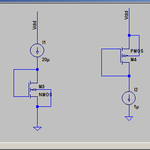Alper özel
Member level 1
- Joined
- Feb 28, 2015
- Messages
- 40
- Helped
- 0
- Reputation
- 0
- Reaction score
- 0
- Trophy points
- 6
- Location
- Turkey / Scotland
- Activity points
- 487
I have to use LtSpice to design an opAmp with pre determined MOS library: http://ptm.asu.edu/modelcard/2006/130nm_bulk.pm
However, I have no experience with LtSpice before and I really could not find what I want on internet so I am asking to you: How do I calculate the Vth so Mn*Cox in LtSpice?
I thought Vth0=0.378 was the threshold value of NMOS and Vth=-0.321 of PMOS according to the library text:
+vth0 = 0.3782 k1 = 0.4 k2 = 0.01 k3 = 0
+vth0 = -0.321 k1 = 0.4 k2 = -0.01 k3 = 0
However when I calculate the NMOS MnCox for I=10 u and 20 u in this configuration:

I get MnCox as 1.32m and 0.9m differently. So this calculation makes no sense. And what is the correct way to calculate it? Thanks.
However, I have no experience with LtSpice before and I really could not find what I want on internet so I am asking to you: How do I calculate the Vth so Mn*Cox in LtSpice?
I thought Vth0=0.378 was the threshold value of NMOS and Vth=-0.321 of PMOS according to the library text:
+vth0 = 0.3782 k1 = 0.4 k2 = 0.01 k3 = 0
+vth0 = -0.321 k1 = 0.4 k2 = -0.01 k3 = 0
However when I calculate the NMOS MnCox for I=10 u and 20 u in this configuration:

I get MnCox as 1.32m and 0.9m differently. So this calculation makes no sense. And what is the correct way to calculate it? Thanks.
